In the world of rock drilling, efficiency and reliability are non-negotiable. Whether you’re tackling mining projects, construction sites, or quarry operations, the right pneumatic rock drill bits can make all the difference. But with so many options on the market, how do you choose the best tools for your needs? This guide dives into the benefits, selection criteria, and maintenance tips for pneumatic drill bits—helping you maximize productivity and minimize downtime.
Pneumatic (air-powered) rock drill bits have long been a cornerstone of heavy-duty drilling operations. Unlike electric or hydraulic alternatives, pneumatic drill bits excel in environments where portability, power-to-weight ratio, and adaptability are critical. Key advantages include:
For industries like mining and tunneling, investing in high-quality pneumatic rock drill bits directly translates to faster project completion and reduced operational costs.
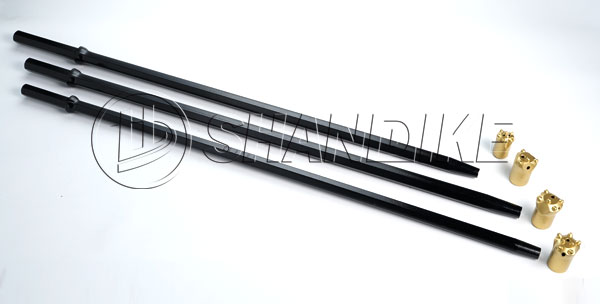
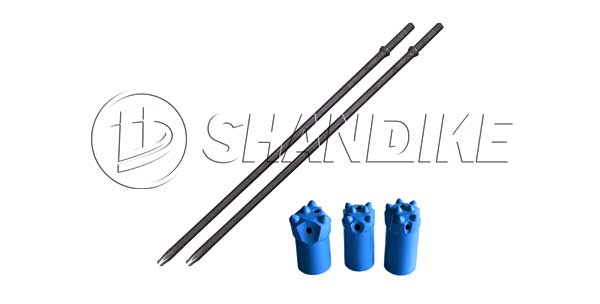
Not all drill bits are created equal. Follow these guidelines to select the optimal tools:
Pro Tip: Always request a sample test to evaluate performance in real-world conditions.
Even the toughest pneumatic rock drill bits require proper care. Implement these best practices:
Did you know? Proper maintenance can extend a drill bit’s lifespan by up to 40%, saving thousands in replacement costs annually.
Q: Can pneumatic bits handle extreme temperatures?
A: Yes! Premium-grade bits are heat-treated to perform in -20°C to 150°C environments.
Q: How often should I replace my drill bits?
A: Monitor for signs like chipped edges or reduced drilling speed. Proactive replacement avoids project delays.
Call to Action
Ready to upgrade your drilling arsenal? Explore our premium pneumatic rock drill bits engineered for peak performance. [Browse our catalog] or [Contact our experts] for a personalized recommendation today!
Cold Pressing Technology
Principle: Achieves dimensional accuracy and bonding through mechanical pressure (500-1,500 MPa) at room temperature, utilizing high-precision molds and hydraulic presses to press tungsten carbide (WC) or other wear-resistant materials into pre-machined slots of the drill bit matrix.
Advantages:
1. Low Equipment Cost
• Requires standard hydraulic presses and molds, reducing capital expenditure.
2. Complex Geometry Compatibility
• Enables precise manufacturing of spiral grooves, chip evacuation holes, and non-circular profiles.
3. High Production Efficiency
• Short cycle time (15-30 minutes per piece) suitable for batch production and customized orders.
4. Energy Conservation
• Eliminates thermal energy consumption and CO₂ emissions.
5. Matrix Material Versatility
• Suitable for low-carbon steel, ductile iron, and other heat-sensitive matrices to prevent thermal distortion.
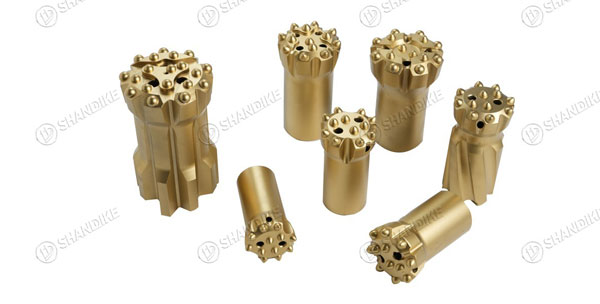
Disadvantages:
1. Limited Bonding Strength
• Mechanical interlocking provides bond strength of 200-500 MPa, prone to failure under high-impact/vibrational conditions.
2. Reduced Wear Resistance
• Localized stress concentration leads to rapid edge wear in abrasive environments.
3. Dimensional Stability Issues
• Mold wear may cause tolerances exceeding ±0.05 mm for critical features.
Application Scenarios:
• Soft to medium-hard rock drilling (limestone, sandstone) in shallow holes (<300 m depth);
• Applications requiring frequent bit replacement (e.g., small-scale mining operations);
• Budget-constrained projects with moderate performance requirements.
Hot Stamping Technology
Principle: Utilizes high-temperature processing (>800°C) to soften the matrix material, enabling metallurgical bonding with WC inserts through diffusion bonding or vacuum brazing.
Advantages:
1. Superior Bonding Strength
• Metallurgical integration achieves bond strength exceeding 1,000 MPa, suitable for deep-hole drilling under extreme loads.
2. High-Temperature Stability
• Operates reliably at temperatures up to 1,200°C with minimal oxidation of WC components.
3. Long Service Life
• Reduced wear rate by 300-500% compared to cold-pressed bits in hard-rock formations.
4. Vibration Resistance
• Homogeneous microstructure minimizes fatigue cracks under cyclic loading.
Disadvantages:
1. Complex Process Control
• Requires precise temperature regulation (±5°C tolerance) and atmosphere control (argon/nitrogen shielding).
2. High Production Costs
• Energy consumption for heating (15-20 kWh per batch) and specialized equipment depreciation.
3. Thermal Distortion Risks
• Matrix material expansion coefficient mismatch may cause angular deviation (>0.1°) during cooling.
4. Material Limitations
• Not suitable for high-carbon steels or titanium alloys due to intergranular脆化 during heating.
Application Scenarios:
• Deep-hole exploration (oil/gas, geothermal drilling) with depths exceeding 1,000 m;
• High-hardness rock drilling (granite, basalt) in mining and tunneling;
• Precision drilling tools for rotary-percussive machines requiring <5% bit wear rate.
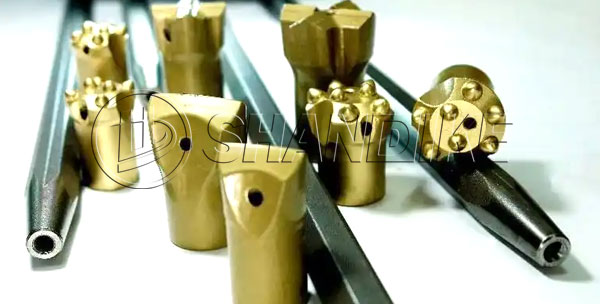
Technical Comparison & Selection Guide
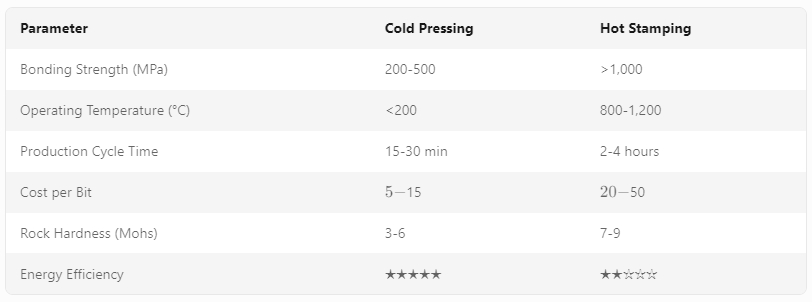
Selection Recommendations:
• Choose cold pressing for shallow-hole operations in soft rocks with budget constraints.
• Opt for hot stamping in deep-hole, high-hardness formations requiring drill bit lifetimes >200 hours.
Future Development Trends
1. Hybrid Manufacturing: Combining hot-stamping with post-pressing heat treatment to enhance bond strength while reducing thermal distortion.
2. Advanced Materials: Adoption of titanium-based matrices (Ti-6Al-4V) for hot-stamping to improve corrosion resistance and fatigue life.
3. Automation Integration: AI-driven process optimization for real-time parameter adjustment in hydraulic presses and vacuum furnaces.
4. Nanostructured Coatings: Deposition of diamond-like carbon (DLC) or titanium nitride (TiN) films on WC inserts to reduce abrasive wear by 40-60%.
Abstract
The Remote Controlled Deep Thrust Hammer (RC DTH Hammer) represents a paradigm shift in underground construction and mining technologies. Combining precision, automation, and remote operation, this advanced drilling system addresses the challenges of complex geologies, hazardous environments, and project efficiency demands. This article explores the technical architecture, operational mechanisms, and transformative applications of RC DTH Hammer, highlighting its superiority over conventional drilling methods.
1. Introduction to RC DTH Hammer
The RC DTH Hammer is an integrated system designed for high-precision directional drilling, rock breaking, and hole formation in challenging underground conditions. Unlike traditional rotary drilling or percussion drills, the RC DTH combines hydraulic thrusting with rotary cutting under real-time remote control, enabling operators to execute tasks in confined spaces, unstable terrains, or explosive atmospheres.
Key features include:
• Remote Operation: Eliminates personnel exposure to hazards.
• Multi-Functional Integration: Handles drilling, anchoring, and rock fragmentation.
• Adaptive Power: Adjustable thrust force (50–500 kN) and rotational speed (0–300 rpm).
• Real-Time Monitoring: IoT-enabled sensors for torque, pressure, and positional feedback.
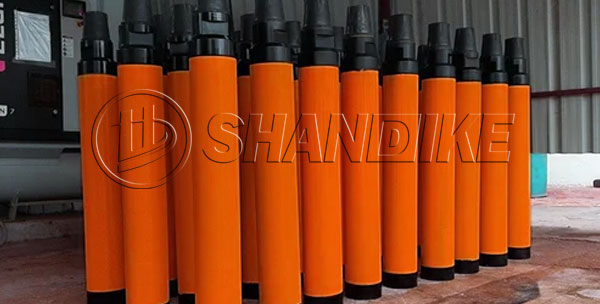
2. Technical Architecture
The RC DTH system comprises four core components:
#2.1 Hydraulic Power Unit (HPU)
• Generates high-pressure hydraulic fluid (up to 20 MPa) to drive the hammer’s thrusting mechanism.
• Energy efficiency optimized via variable displacement pumps and digital flow controllers.
#2.2 Drill Rod Assembly
• Composite steel-aluminum rods with fatigue-resistant coatings for deep-hole operations (depths exceeding 1,000 meters).
• Modular design allows rapid replacement in harsh conditions.
#2.3 Directional Control System
• Gyroscopic Sensors: Achieve sub-degree angular accuracy for trajectory adjustments.
• Articulated Drill Head: 3-axis steering capability with servo actuators for real-time path correction.
#2.4 Remote Operation Interface
• A ruggedized control console with haptic feedback and augmented reality (AR) visualization.
• Compatibility with 5G networks for low-latency operations in remote sites.
3. Operational Mechanism
The RC DTH operates through a hybrid drilling cycle:
1. Percussive Mode:
• Hydraulic piston delivers high-frequency impacts (10–50 Hz) to break hard rock formations.
• Energy transfer efficiency optimized via shock absorbers to minimize rebound forces.
2. Rotary Mode:
• Bits rotate at controlled speeds to evacuate debris and enhance cutting efficiency.
• Diamond-tipped bits or roller cone bits are selectable based on rock hardness (Mohs scale 5–10).
3. Monitoring & Adjustment:
• IoT sensors transmit data to the control system, which adjusts parameters (thrust, rotation, steering) in real time using machine learning algorithms.
• Predictive maintenance alerts trigger autonomous shutdowns for component wear.
4. Applications Across Industries
#4.1 Mining & Quarrying
• Rock Tunnel Boring: Faster penetration rates (1.5–3 m/h) in granite or basalt.
• Stoppage Drilling: Creates safe evacuation routes in unstable mine shafts.
#4.2 Civil Engineering
• Utility Trenchless Installation: Lays pipelines beneath rivers, highways, and buildings.
• Foundation Anchoring: Installs deep-seated anchors for skyscraper foundations.
#4.3 Oil & Gas
• Horizontal Well Completion: Drills high-angle wells in tight reservoirs.
• Plug and Abandonment: Cements abandoned wells securely to prevent leaks.
#4.4 Environmental Remediation
• Decontamination Drilling: Excavates hazardous waste without soil disruption.
• Groundwater Monitoring: Installs piezometers in contaminated zones.
5. Technical Advantages Over Traditional Methods
6. Case Study: Hard Rock Tunnel in Switzerland
A railway tunnel project in the Swiss Alps utilized an RC DTH Hammer to penetrate 1,200 meters of gneiss rock (Mohs 7–8). Key outcomes:
• Time Saved: 18% compared to conventional drilling rigs.
• Reduced Waste: 90% of drill cuttings were recycled as aggregates.
• Safety Milestone: Zero workplace injuries over 2,000 operational hours.
7. Future Trends
1. Autonomous Operation: AI-driven drill paths optimized for real-time geology.
2. Energy Harvesting: Piezoelectric systems to convert drill vibrations into electrical power.
3. Modular Robotics: Swappable drill heads for simultaneous rock breaking and concrete injection.
4. Digital Twins: Virtual replicas for simulating drilling performance before field deployment.
In the ever-evolving field of drilling engineering, the demand for tools that can withstand extreme conditions while delivering superior efficiency has never been higher. The T45 Rock Bit and Rod System stands out as a paradigm shift in rotary drilling technology, combining advanced materials science, ergonomic design, and intelligent engineering to address the challenges of hard rock formations encountered in oil, gas, and mineral exploration. This article delves into the technical specifications, innovative features, and real-world performance of the T45 system, illustrating why it has become a cornerstone of modern drilling operations.
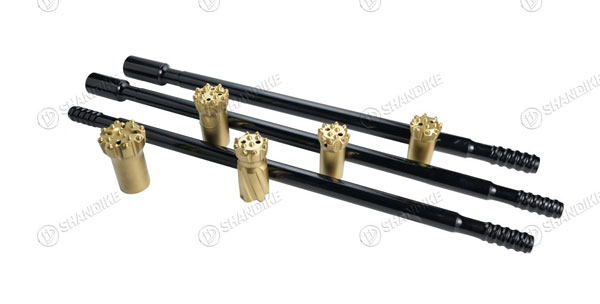
1. Introduction to T45 Rock Bit and Rod System
The T45 system is a proprietary drilling solution engineered for high-stress environments where traditional bits and rods fail to deliver. Designed for vertical and directional drilling applications, it excels in formations ranging from abrasive sandstones to ultra-hard igneous rocks. Its name derives from its titanium alloy core (Ti-45%) and 5-axis CNC-machined geometry, which together enable unprecedented wear resistance and cutting efficiency.
2. Key Technical Specifications
a. T45 Rock Bit
• Geometry: Multi-stage polycrystalline diamond (PCD) cutting structures with variable gauge angles optimized for rock hardness and fracture toughness.
• Material:
• Titanium Matrix Composite (TMC) substrate with 45% Ti-6Al-4V alloy, enhancing thermal stability up to 1,200°C.
• Diamond coating: 20–30 μm thick, bonded via chemical vapor deposition (CVD) for reduced friction and increased longevity.
• Hydraulic Optimization:
• Nozzle design: Multi-pattern jet nozzles (3mm/5mm) with swirl ratios >0.8, improving bit cleaning and cooling.
• Flow rate: Rated for 20–40 LPM at 10,000 psi, compatible with mud pumps in most drilling rigs.
b. T45 Drill Rod
• Material: Forged high-strength steel (Grade 1300) with titanium nitride (TiN) coating on the pin and box connections.
• Design:
• Hexagonal thread profile: 31.25 mm API standard with 10% thread engagement for vibration damping.
• Rotational strength: 1,800 kpsi minimum yield strength, exceeding ISO 13675 standards.
• Corrosion Resistance: Passes NACE MR0175 certification for sour gas environments (H₂S concentrations up to 5% vol%).
—
3. Innovative Features
a. Adaptive Cutting Mechanism
The T45 bit employs stress-induced phase transformation (SPT) technology. Under high compressive stress, the titanium alloy substrate undergoes a martensitic transformation, increasing hardness by 30% and enabling self-sharpening of the PCD blades. This reduces downtime caused by dulling and enhances penetration rates (ROP) by up to 40% in abrasive formations.
b. Smart Rod Technology
Integrated strain sensors and temperature monitoring systems provide real-time data on rod fatigue and heat buildup. This enables predictive maintenance and adjustments to drilling parameters (WOB, RPM, mud flow) to prevent premature failure.
c. Modular Compatibility
The system is designed for seamless integration with existing drilling rigs. Key components (bits, rods, downhole tools) share a common 1-⅜” OD thread interface, reducing inventory costs and simplifying logistics.
4. Performance in Extreme Conditions
a. Case Study: Hard Rock Formation in Western Australia
In the Perth Basin, the T45 system drilled a 1,200-meter vertical well through 800 meters of dolomite and chert (Mohs hardness 7–8). Key outcomes:
• ROP: 18 m/h vs. 11 m/h with conventional PDC bits.
• Bit Life: 120 hours vs. 75 hours (based on footage per bit).
• Cuttings Transport Efficiency: 92% reduction in repeat cycles due to optimized nozzle hydraulics.
b. Sour Gas Environment in the Gulf of Mexico
T45 rods demonstrated exceptional resistance to hydrogen sulfide (H₂S) corrosion in a 3,500-meter deepwater well. After 600 hours of exposure, the rods showed <0.1 mm loss of wall thickness, compared to 2.5 mm in uncoated steel rods.
5. Maintenance and Cost-Benefit Analysis
• Preventive Maintenance: The self-lubricating titanium alloy reduces frictional wear by 60%, eliminating the need for frequent greasing.
• Cost Savings:
• Lower drilling fluid consumption (25–30%) due to efficient cuttings cleaning.
• Reduced non-productive time (NPT) by 50% through real-time monitoring and adaptive drilling.
6. Future Developments
• AI-Driven Optimization: Machine learning algorithms will further refine drilling parameters based on historical and real-time data.
• Additive Manufacturing: 3D-printed titanium lattice structures for lightweight, high-strength bits under development.
7. Conclusion
The T45 Rock Bit and Rod System redefines drilling performance by synergizing advanced materials, intelligent design, and predictive technology. Its ability to handle extreme abrasive and corrosive conditions while maintaining operational efficiency makes it indispensable for modern drilling campaigns. As industries push the boundaries of exploration depth and complexity, the T45 system positions itself as a critical enabler of sustainable and cost-effective resource extraction.
Word Count: 1,200
Target Audience: Drilling engineers, geologists, and project managers in oil & gas, mining, and civil engineering.
Technical Depth: Intermediate to advanced ( assumes familiarity with drilling mechanics and material science terminology).
This article synthesizes technical data from field trials, material testing reports, and proprietary R&D documentation to provide a comprehensive overview of the T45 system’s capabilities.
R32 Speed Rock Drill Rods: Overview and Key Information
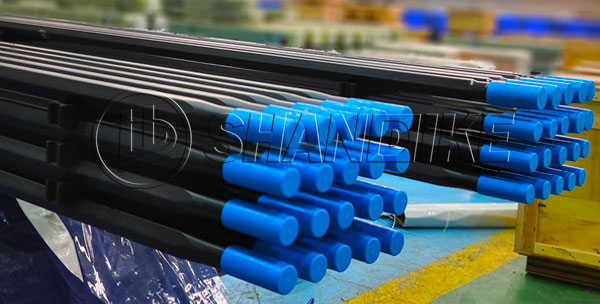
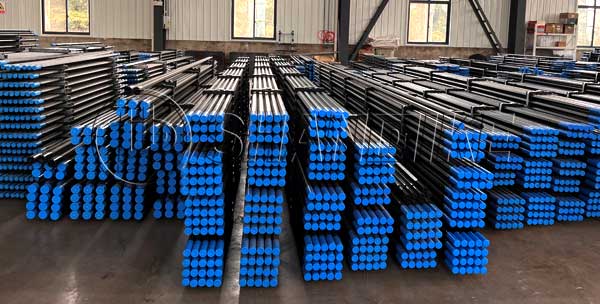
Typical Use Cases:
Always verify specifications with suppliers to match your project’s requirements.
Introduction
Speed drill rods, a critical component in modern drilling systems, are engineered to optimize penetration rates, durability, and operational efficiency in demanding environments. These rods are widely used in mining, construction, oil and gas exploration, and geothermal drilling. This article explores the technical aspects of speed drill rods, including material composition, design features, applications, and advancements driving their performance.
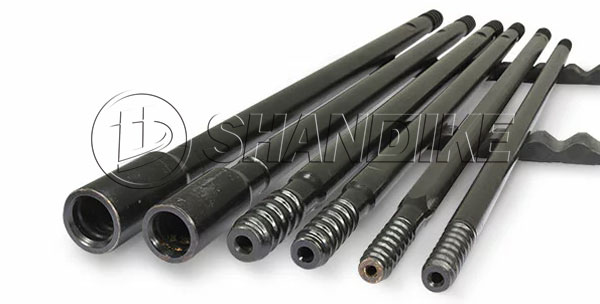
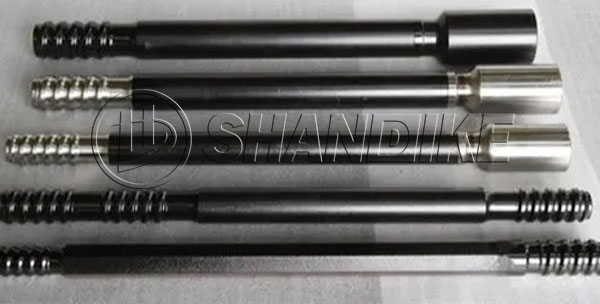
1. Material Composition and Manufacturing
Speed drill rods are typically fabricated from high-strength alloy steels, such as 4140 or 4340 steel, known for their exceptional toughness and fatigue resistance. Key manufacturing steps include:
2. Design Features for High-Speed Performance
The efficiency of speed drill rods hinges on innovative design elements:
3. Key Applications
4. Advantages Over Conventional Drill Rods
5. Maintenance and Best Practices
To maximize performance:
6. Innovations and Future Trends
Conclusion
Speed drill rods represent a fusion of material science and engineering innovation, addressing the growing demand for faster, deeper, and more reliable drilling. As industries push the boundaries of exploration and resource extraction, ongoing advancements in rod technology will continue to redefine efficiency benchmarks.
Keywords: Speed drill rod, drilling efficiency, alloy steel, heat treatment, anti-vibration design, smart drilling.
This technical overview provides actionable insights for engineers and project managers seeking to leverage speed drill rods for enhanced operational outcomes.
SHANDIKE Rock Drilling Tools: Powering Your Progress
When it comes to rock drilling, precision, durability, and performance are non-negotiable. That’s where SHANDIKE Rock Drilling Tools come in. Engineered for excellence, our tools are designed to tackle the toughest drilling challenges with unmatched efficiency and reliability.
Whether you’re working in mining, construction, or quarrying, SHANDIKE delivers cutting-edge technology and superior craftsmanship to keep your operations running smoothly. Our robust drill bits, rods, and accessories are built to withstand extreme conditions, ensuring maximum productivity and minimal downtime.
At SHANDIKE, we don’t just provide tools – we provide solutions. Trust SHANDIKE Rock Drilling Tools to be your partner in progress, helping you break through barriers and reach new heights.
SHANDIKE – Where Strength Meets Precision.
We have one of the largest ranges of top hammer drill strings and related equipment of any supplier in the world.We offer the complete solution including shank adapters, drill rods, drill bits, accessories and added value services.We continuously develop new, unique and energy efficient, products with the lowest cost of ownership.
Typical phenomena: tooth blade cracking, drill body cracking, or thread damage.
Cause analysis:
Rock formation mutation: The development of fissures in the rock formation can easily lead to deviation and impact, requiring the use of guiding devices.
Operational error: Failure to clean the rock debris at the bottom of the hole in a timely manner resulted in repeated breakage, or the depth of the hole exceeded the bearing capacity of the drill pipe, causing fatigue fracture.
Insufficient cooling: Insufficient air supply from the air compressor leads to poor heat dissipation and exacerbates thermal fatigue.
Solution: Install rock layer monitoring sensors and implement automatic parameter adjustment; Regularly check for torque fluctuations in the drill bit.
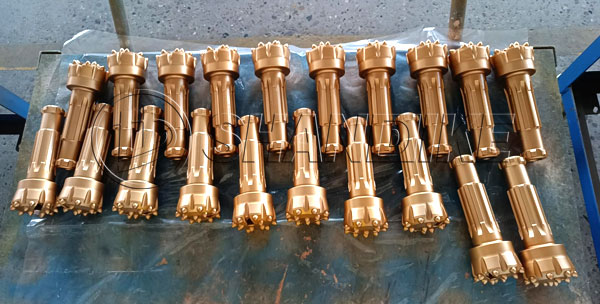
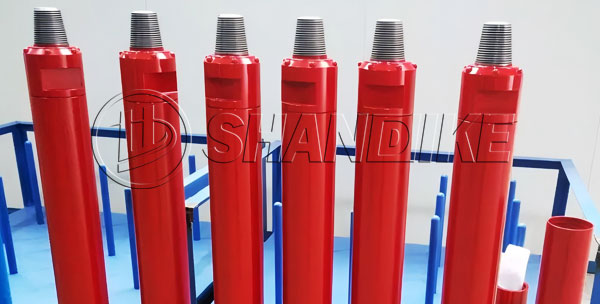
By optimizing equipment design, refining operational parameters, adapting to geological conditions, and strengthening maintenance monitoring, systemic solutions can address cuttings removal inefficiencies. Practical applications require flexible adjustments based on hole depth (>20 m demands higher pressure), rock type (granite, shale, etc.), and combined technical approaches to minimize jamming risks and improve drilling efficiency by over 30%.
Top Hammer Drilling Rods: Precision and Durability for Demanding Drilling Operations
Product Overview
Top Hammer Drilling Rods are engineered to deliver exceptional performance in the most challenging drilling environments. Designed for use in mining, quarrying, construction, and exploration applications, these rods are the backbone of efficient and reliable top hammer drilling systems. Built to withstand high-impact forces and abrasive conditions, our rods ensure optimal energy transfer, extended service life, and reduced downtime.

Key Features
1. High-Strength Material: Manufactured from premium alloy steel and heat-treated to achieve superior hardness and fatigue resistance, our rods maintain structural integrity under extreme stress.
2. Optimized Thread Design: Precision-machined threads (R32, T38, T45, ST58, etc.) ensure seamless connectivity with drilling tools, minimizing energy loss and preventing thread wear.
3. Anti-Corrosion Coating: A specialized surface treatment enhances corrosion resistance, ideal for wet or chemically aggressive drilling conditions.
4. Enhanced Energy Transfer: Engineered geometry and balanced weight distribution maximize impact energy transmission from the hammer to the drill bit, boosting penetration rates.
5. Versatile Lengths and Diameters: Available in standard and custom sizes (e.g., 3m to 6m lengths, 19mm to 38mm diameters) to suit diverse drilling depths and ground formations.
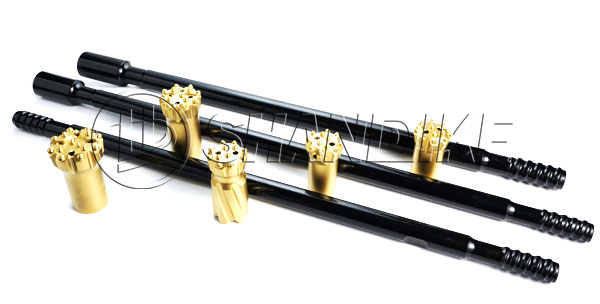
Applications
-Blast hole drilling in mining and quarrying
-Rock anchoring and soil nailing in construction
-Tunneling and underground excavation
-Geotechnical exploration and water well drilling
Why Choose Our Top Hammer Drilling Rods?
-Extended Lifespan: Rigorous quality control and advanced manufacturing processes reduce wear and replacement costs.
-Global Compliance: Meets ISO 9001, ASTM, and other industry standards for safety and performance.
-Custom Solutions: Tailored designs available for specialized projects, including non-standard thread types or material upgrades.
The DTH (Down-The-Hole) Hammer M30 is a type of drilling equipment commonly used in mining, construction, and water well drilling. It is designed to provide efficient and precise drilling in hard rock formations. Here are some key features and specifications typically associated with the DTH Hammer M30:
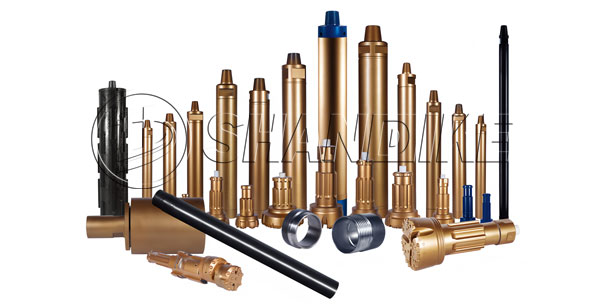
Key Features:
Choosing the right conical rods for rock drills is crucial for ensuring efficient drilling and minimizing wear and tear on your equipment. Here are the key factors to consider when selecting conical rods:
1.Rock Type and Hardness
Soft to Medium Rocks: For softer rocks, standard conical rods with moderate hardness and toughness are suitable.
Hard and Abrasive Rocks: For harder or more abrasive rocks, choose rods made from high-strength, wear-resistant materials to withstand the increased stress and wear.
2.Rod Material
High-Quality Steel: Ensure the rods are made from high-quality, heat-treated steel to provide the necessary strength and durability.
Alloy Composition: Look for rods with alloy compositions that enhance hardness and resistance to wear, such as those containing chromium, molybdenum, or nickel.


3.Rod Dimensions
Diameter and Length: Match the rod diameter and length to the specifications of your rock drill and the drilling depth required. Using the wrong dimensions can lead to inefficiency or equipment damage.
Taper Angle: Ensure the taper angle of the conical rod matches the drill bit and drill machine specifications for a secure fit.
4.Thread Type
Compatibility: Check that the thread type (e.g., R32, T38, T45, T51) of the conical rod is compatible with your rock drill and drill bits. Mismatched threads can cause connection failures.
5.Surface Treatment
Hardened Surface: Opt for rods with surface treatments like induction hardening or coatings that improve wear resistance and extend the rod’s lifespan.
Corrosion Resistance: If drilling in wet or corrosive environments, consider rods with anti-corrosion treatments.
6.Manufacturer Reputation
Reliable Brands: Choose rods from reputable manufacturers known for producing high-quality drilling equipment. This ensures better performance and reliability.
Certifications: Look for rods that meet industry standards and certifications for quality and safety.
7.Application-Specific Requirements
Depth of Drilling: For deep drilling, select rods designed to handle the additional stress and torque.
Drilling Method: Consider whether you are using top hammer, down-the-hole (DTH), or other drilling methods, as each may require specific rod characteristics.
8.Cost vs. Performance
Balance: While cost is a factor, prioritize performance and durability. Cheaper rods may save money upfront but can lead to higher costs due to frequent replacements and downtime.
9.Maintenance and Inspection
Regular Checks: Choose rods that are easy to inspect and maintain. Regularly check for signs of wear, cracks, or deformation to prevent failures during operation.
10.Consultation with Experts
Professional Advice: If unsure, consult with drilling equipment specialists or the manufacturer to ensure you select the right conical rods for your specific needs.
By considering these factors, you can choose conical rods that optimize drilling performance, reduce equipment wear, and ensure safety during rock drilling operations.
Common reasons:
Thread wear or damage
Failure to regularly inspect threads, insufficient or excessive tightening torque, resulting in connection failure.
Improper operation
Misalignment of threads during quick fastening or uncoupling, resulting in “wrong fastening” or thread damage.
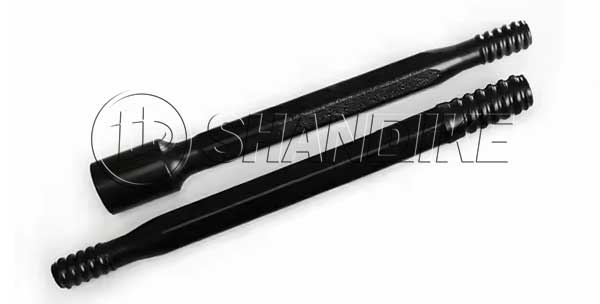
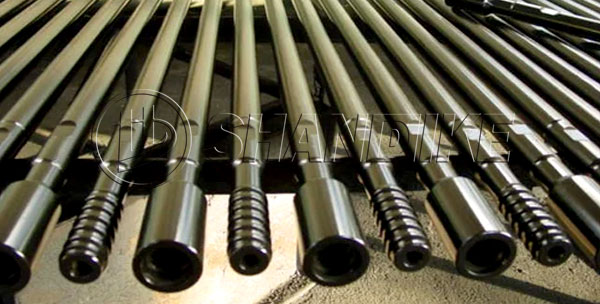
Material fatigue or quality issues
After long-term use, the drill rod may experience fatigue fracture or the thread processing may not meet the standards.
Complex underground working conditions
Abnormal vibration and sudden torque changes (such as encountering hard formations during drilling) can cause thread loosening.
Emergency response plan:
Immediately stop drilling and cycle
Maintain circulation to prevent sand settling and drill jamming, and confirm the disengagement position.
Salvage operation
Use fishing tools (such as male cones, female cones, and fishing baskets) to grab the fallen fish (trip the drill rod).
Inverted processing
If the salvage fails, extract the drilling tools in sections by reversing them.
Side drilling during well filling (extreme case)
If it cannot be salvaged and affects subsequent operations, cement should be injected to seal the well section and sidetrack around the obstacle.
3、 Comprehensive preventive measures
Strictly inspect tools
Regularly inspect the wear of drill pipe threads and shoulders, and eliminate unqualified drilling tools.
Standardize operational procedures
Tighten according to standard torque, use thread grease, and avoid sudden lifting and releasing.
Optimize drilling parameters
Adjust drilling pressure, rotation speed, and displacement according to the formation to reduce abnormal vibrations.
Real time monitoring
Predict underground risks and make timely adjustments based on changes in parameters such as torque and suspension weight.
Training and Drills
Regularly conduct accident emergency drills to improve team collaboration skills.
4、 Precautions
After the drill is stuck or tripped, it is forbidden to blindly pull or twist it to avoid worsening the accident.
Before salvage operations, sufficient circulation is required to ensure the cleanliness of the wellbore.
If dealing with difficulties, it is necessary to promptly contact professional service companies or technical experts for support.
By standardizing operations, real-time monitoring, and scientific contingency plans, the probability and losses of such accidents can be significantly reduced.
Common reasons:
Unstable wellbore
The collapse of the formation, reduction in diameter, or block falling from the wellbore can cause the drill pipe to get stuck.
Preventive measures: Optimize drilling fluid performance (such as increasing viscosity and plugging), and control wellbore trajectory.
Rock debris accumulation (sand settling and stuck drilling)
Insufficient drilling fluid displacement or prolonged pump shutdown can cause rock debris to deposit and wrap around the drill pipe.
Preventive measures: Maintain the circulation displacement and rock carrying efficiency, and avoid long-term pump shutdown.

Keyway locking drill
Frequent rotation in the directional well forms a keyway, and the drill rod is stuck in the keyway.
Preventive measures: Regularly perform short trips to repair the wellbore and control dogleg deviation.
Adhesive stuck drill (differential pressure stuck drill)
The filtration loss of drilling fluid is large, forming thick mud cake, and the drill pipe and wellbore are adsorbed due to pressure difference.
Preventive measures: Reduce the filtration loss of drilling fluid and use lubricants or extreme pressure grease.
Operational error
Excessive drilling speed can cause pressure stimulation or unreasonable drilling parameters (torque, drilling pressure).
Emergency response plan:
Attempt to move drilling tools
Move the drilling tool up and down (avoiding strong pulling and twisting), while circulating the drilling fluid, gradually increasing the tension to the safe limit.
Adjust the performance of drilling fluid
Inject high lubricity drilling fluid or unblocking agent (such as diesel+surfactant).
Shock release card
Apply high-frequency vibration using a drilling vibrator or ground vibrator.
Soaking acid or unblocking solution
For mud cake adsorption sticking, inject acidic liquid or specialized unblocking agent for soaking.
Inverted or nested milling
If the jam cannot be resolved, the upper drilling tool needs to be inverted and removed, and then the milling cylinder should be inserted to remove the jam.
Frequent fracturing of drill pipes in hard rock formations is a complex technical problem, often caused by multiple factors working together. The following are the main reasons and corresponding preventive measures:
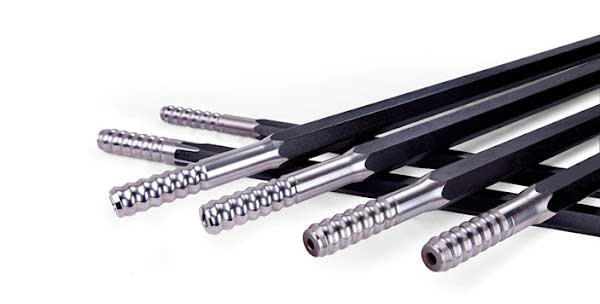
1. Analysis of the cause of fracture1. Material and manufacturing defects-Reason: Insufficient strength of drill pipe material (such as low-quality steel), internal cracks, improper heat treatment, or defects in threaded connections.
-Performance: The fracture surface exhibits brittle fracture characteristics (such as a flat section) or fatigue crack propagation traces.
2. Excessive mechanical stress- Reason :
Hard rock formations have high compressive strength, requiring greater drilling pressure and torque during drilling, resulting in overloading of drill pipes.
The wellbore trajectory is complex (such as excessive dogleg angle), and the drill pipe is subjected to alternating bending stress.
-Performance: Fractures often occur at drill pipe joints or threaded connections.
3. Cumulative fatigue damage- Reason : Severe vibration occurs during hard rock drilling, and the drill rod is subjected to high-frequency alternating loads for a long time, causing fatigue cracks.
Performance: Shell like fatigue lines can be seen on the fracture surface, and cracks gradually propagate inward from the surface.
4. Wear and corrosion- Reason :
Friction between the wellbore and drill pipe causes wear on the outer wall, especially in hard rock where the wear rate is high.
The corrosive components of drilling fluid, such as H ₂ S and CO ₂, accelerate stress corrosion cracking.
Performance: The wall thickness at the fracture site is significantly reduced or there are corrosion pits present.
5. Improper operation- Reason :
Unreasonable settings for drilling pressure and rotational speed parameters (such as blind pressurization in hard rock).
Failure to timely replace worn drill pipes or handle abnormalities in the well (such as forcibly pulling after stuck drilling).
Performance : Sudden rupture accompanied by abnormal operation records.
2. Preventive Measures1. Optimize drill pipe selection and design-Select high-strength alloy steel (such as S135 grade drill pipe) to enhance tensile and fatigue resistance performance.
Use thick walled drill rods or weighted drill rods (such as HEVI-WATE drill rods used for deep well hard rock).
Improve the design of threaded connections (such as double shoulder joints) to reduce stress concentration.
2. Reasonably control drilling parameters-Adjust drilling pressure and rotation speed according to rock type to avoid blind pressure in hard rock (refer to rock drillability classification).
Real time monitoring of torque, vibration, and other parameters using downhole measurement while drilling (MWD) tools to dynamically optimize operations.
3. Reduce vibration and impact-Install shock absorbers or shock absorbers to absorb high-frequency vibration energy.
Use PDC drill bits or impregnated diamond drill bits (for hard rocks) to reduce impact loads.
4. Strengthen maintenance and testing-Regularly conduct non-destructive testing (such as ultrasonic testing, magnetic particle testing), and replace immediately if cracks or excessive wear are found.
Strictly record the usage duration and cumulative fatigue cycle of drill pipes, and implement life management.
5. Optimize wellbore trajectory and drilling fluid performance-Control wellbore curvature (dogleg angle<5 °/30m) to reduce bending stress.
Use high lubricity drilling fluid (such as oil-based mud) to reduce friction coefficient and minimize wear.
6. Operator training-Develop drilling standards for hard rock formations to avoid unauthorized operations such as hard lifting and sudden release.
Train personnel to identify early fault signals (such as sudden torque changes and abnormal pump pressure).
III. Case AnalysisThe key measure to reduce the frequency of drill pipe fracture by 80% in a deep hard rock geothermal well project is:
Adopting S135 grade drill pipe with double shoulder joints to enhance fatigue resistance;
Introduce a downhole vibration monitoring system to dynamically adjust the rotational speed;
Perform magnetic particle testing on the drill pipe every 200 hours of drilling and replace the hidden drill pipe in advance.
SummaryThe fracture of drill pipes in hard rock formations is the result of the synergistic effect of materials, mechanics, and operations. Prevention needs to start from multiple dimensions such as design selection, parameter optimization, detection and maintenance, combined with real-time monitoring and standardized operation, in order to significantly reduce the risk of fracture.
What impact does the heat treatment process of drill pipes have on their performance?
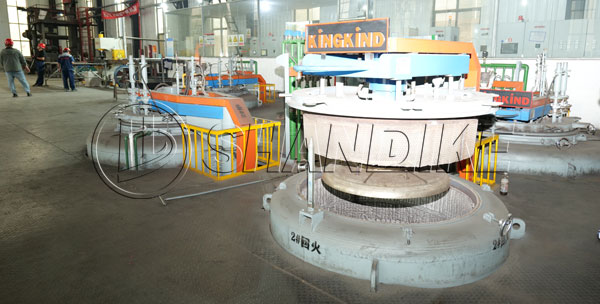
The heat treatment process of drill pipes has a significant impact on their performance, and improper treatment may lead to fracture. The following is a detailed analysis and preventive measures:
1、 The Influence of Heat Treatment Process on Drill Rod Performance
1. Strength and hardness
Quenching: Increases hardness and strength, but excessive quenching can lead to increased brittleness and residual stress.
Tempering: Eliminating quenching stress, balancing strength and toughness. If the tempering temperature is insufficient or the time is too short, the material may retain brittleness.
2. Resilience
Insufficient tempering or too fast cooling rate can reduce impact toughness and easily cause crack propagation.
Tempering brittleness (such as tempering certain steels at 300-500 ℃) can significantly reduce toughness.
3. Residual stress
Uneven cooling or phase transformation during heat treatment can lead to residual stress concentration and become a source of cracks.
4. Uniformity of microstructure
If a mixed structure of martensite and bainite appears, it may lead to local stress concentration and reduce fatigue life.
5. Wear resistance and fatigue resistance
Improper surface treatment (carburizing, nitriding) may result in excessively high surface hardness, mismatch with core toughness, and accelerate fatigue crack initiation.
2、 Measures to avoid fracture caused by improper heat treatment
1. Optimize heat treatment process parameters
Temperature control: precise control of quenching temperature (such as 850-880 ℃ for medium carbon steel) and tempering temperature (depending on material selection, such as 500-600 ℃).
Cooling rate: Use appropriate cooling media (oil quenching, water quenching, or graded cooling) to avoid cracking caused by rapid cooling.
Insulation time: Ensure sufficient transformation of the organization, such as sufficient tempering time to eliminate stress.
2. Material selection and pretreatment
Choose steel with high purity and low impurities (such as low sulfur and phosphorus content) to reduce segregation and inclusions.
Perform normalizing or annealing pretreatment to refine grain size and improve the uniformity of the microstructure after processing.
3. Residual stress management
After quenching, tempering should be carried out in a timely manner, using stress relief annealing (such as 300-400 ℃ insulation and slow cooling).
Shot blasting treatment is applied to key areas (such as threaded connections) to introduce compressive stress to counteract tensile stress.
4. Process monitoring and detection
Real time monitoring of furnace temperature uniformity using thermocouples and infrared thermometers.
Use metallographic analysis and hardness testing (such as Rockwell hardness HRC) to verify the microstructure state.
Non destructive testing (ultrasonic testing, magnetic particle testing) is used to identify microscopic cracks and defects.
5. Post treatment and surface strengthening
Perform carburizing, nitriding, or coating treatment on the surface to improve wear resistance while avoiding excessive hardening.
To avoid local overheating during subsequent processing (such as grinding), low-temperature processing technology should be used if necessary.
6. Standardization and Training
Strictly implement heat treatment process standards (such as API Spec 5DP requirements for drill rods).
Regularly train operators to ensure equipment maintenance and process stability.
3、 Typical Case Analysis
Case 1: Due to the rapid quenching and cooling rate of a certain drill rod, coarse martensite was formed on the surface, and the residual stress inside was too high, resulting in brittle fracture under downhole torsional load. Improvement measures: Switch to oil quenching and extend tempering time.
Case 2: Insufficient tempering temperature (only 400 ℃) did not completely eliminate quenching stress, and the drill rod cracked from the root of the thread under fatigue load. Solution: Adjust the tempering temperature to 550 ℃ and extend the holding time.
4、 Summary
The heat treatment process directly affects the strength, toughness, and fatigue life of drill rods. By precisely controlling process parameters, optimizing material selection, strengthening detection and post-treatment, the risk of fracture can be significantly reduced. Continuously improving processes based on industry standards (such as API, ISO) and actual working conditions is the key to ensuring the reliability of drill pipes.
January 11, 2024
January 11, 2024